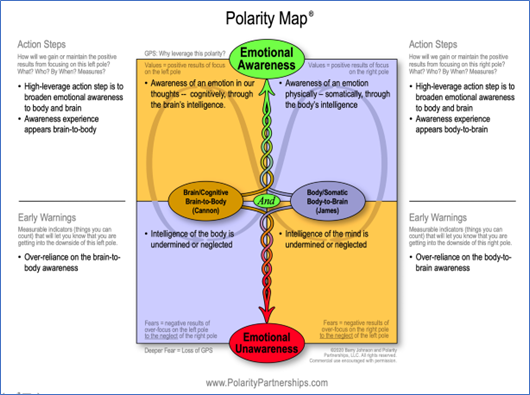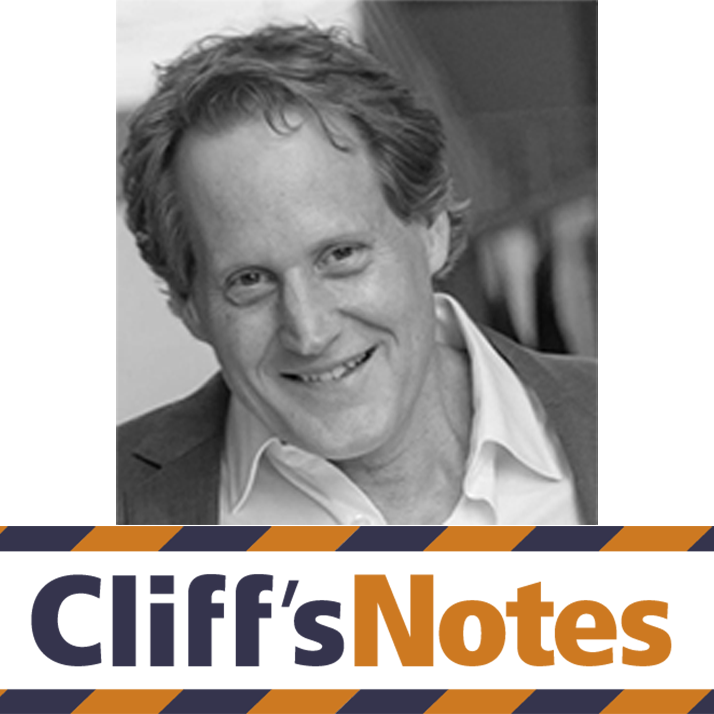Walter Cannon suggested emotions originate in the brain and work their way into the body. William James theorized emotions originate in the body, get perceived in the brain, and we form stories to explain them. Welcome to the Cannon-James debate, ya’ll! Summaries of the two points of view appear at the end of this note, in case you want to “solve” the debate for yourself by choosing “Brain-to-Body” OR “Body-to-Brain”? However…What if…
We were to think about whether this was an “Or” debate that could be “solved” or “resolved” by choosing and looked at it like Inhaling And Exhaling in which they both work together as an interdependent pair – a polarity? If it is in fact, a “Both/And” — “Brain-to-Body” AND “Body-to-Brain” – we’ve done a lot to increase or improve the possibilities. Plus, the focus on the order of operations doesn’t overshadow the central issue (or the Greater Purpose) in the question which seems to be optimizing emotional awareness, right?
Using a Polarity Map® helps us see how both contribute to maximizing awareness in unique ways and how overemphasizing one or the other could minimize awareness. Mayo Clinic physician Elmer Green has described this effect in his biofeedback work for the treatment of disease. He says, “Every change in the physiological state is accompanied by an appropriate change in the mental-emotional state, conscious or unconscious, and conversely, every change in the mental-emotional state, conscious or unconscious, is accompanied by an appropriate change in the physiological state.”

The Body-to-Brain Connection
In 1884 William James published an essay while an assistant professor of philosophy at Harvard concluding the source of emotions is … drum roll, please — purely visceral, originating in the body and not cognitive, originating in mind. We perceive events and have bodily feelings, and then after the perception, which joggles are memories and imagination, we label our physical sensations as one or another emotion. James believed that there is in fact no such entity as emotion. There is simply perception and bodily response. The immediate sensory and motor reverberations that occur in response to the perception end up pounding heart, tight stomach, the tense muscles, the sweaty palms – are the emotions and the emotions are felt throughout the body as sensations. Emotions consist of organic changes in the body, muscular and visceral, and are not a primary feeling directly aroused, but a secondary one, indirectly aroused by the body’s is workings.
“Each morsel of which contributes its pulsations of feeling, dum or sharp, pleasant or painful or dubious, to that sense of personality that every one of us unfailingly carries with him.”
The Brain-to-Body Connection
By the late 1920’s Walter Cannon, an experimental physiologist who authored the book “Wisdom of the Body” had explained emotions in relation to the sympathetic autonomic nervous system. He posited that the vagus nerve was the central component traveling from the brain to the spinal cord and sending branches to many organs including the pupils of the eye, the salivary gland, the heart, the bronchi of the lungs, stomach, the intestines, the bladder, the sex organs, and the adrenal glands. Of even more importance than the vagus nerve was the “seat of the emotions” – the brain’s hypothalamus. Emotions work their way down from the hypothalamus to the body through neuronal connections or secretions of the pituitary gland.
Understanding emotions in a Both/And way keeps both doors open to possibilities for transforming the body and mind, mitigating and healing disease, and supporting overall health and well-being.
In your experiences, what is the source of emotions?
How might a “Both/And” mindset open-up possibilities for supplementing or enhancing your emotional awareness?






